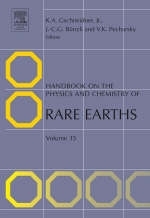
Handbook on the Physics and Chemistry of Rare Earths
North-Holland (Verlag)
978-0-444-52028-9 (ISBN)
- Titel ist leider vergriffen;
keine Neuauflage - Artikel merken
The rare earths play a unique role in science. These seventeen related elements afford a panoply of subtle variations deriving from the systematic development of their electronic configurations, allowing a test of theory with excellent resolution. In contrast they find widespread use in even the most mundane processes such as steel making, for polishing materials and gasoline cracking catalysts. In between are exotic uses such as TV screen phosphors, lasers, high strength permanent magnets and chemical probes.This multi-volume handbook covers the entire rare earth field in an integrated manner. Each chapter is a comprehensive up-to-date, critical review of a particular segment of the field. The work offers the researcher and graduate student alike, a complete and thorough coverage of this fascinating field.
Gschneidner has published over 485 journal articles and chapters in books and edited or written 40 books on the chemistry, materials science, and physics or rare earth materials. He was the founder of the Rare-earth Information Center and served as its Director for 30 years. Jean-Claude Bünzli (he/him) is an Honorary Professor emeritus at the EPFL where he founded the Laboratory of Lanthanide Supramolecular Chemistry He earned a degree in chemical engineering in 1968 and a PhD in 1971 from the Swiss Federal Institute of Technology, Lausanne (EPFL). After two years at the University of British Columbia as a teaching postdoctoral fellow (photoelectron spectroscopy) and one year at the Swiss Federal Institute of Technology in Zürich (physical organic chemistry) he was appointed in 1974 as assistant-professor at the University of Lausanne. He launched a research program on the coordination and spectroscopic properties of f-elements and was promoted to full professor of inorganic and analytical chemistry in 1980. During 2009-2013 he was also a World Class University professor at Korea University (South Korea) at the WCU Center for Next Generation Photovoltaic Devices. In 2016, he has been appointed as adjunct professor at the Haimen Institute of Science and Technology (Haimen, Jiangsu, P.R. China) which is a satellite campus of Hong Kong Baptist University. His research interests deal with various aspects of luminescent lanthanide coordination and supramolecular compounds, developing luminescent bioprobes and bioconjugates for the detection of cancerous cells with time-resolved microscopy as well as luminescent materials for various photonic applications, including solar energy conversion. In 1989, he founded the European Rare Earths and Actinide Society which coordinates international conferences in the field and for which he is presently acting as president. V.K. Pecharsky received a combined BSc/MSc degree in Chemistry (1976) and a PhD degree in Inorganic Chemistry (1979) from Lviv State University (now Ivan Franko National University of Lviv) in Ukraine. He held a faculty appointment at the Department of Inorganic Chemistry at Lviv State University between 1979 and 1993, after which he moved to Ames, Iowa, where he became a staff member at the U.S. Department of Energy Ames Laboratory. In 1998 he accepted a faculty position at the Department of Materials Science and Engineering at Iowa State University, while remaining associated with Ames Laboratory. He was named an Anson Marston Distinguished Professor of Engineering in 2006. He also serves as a Faculty Scientists, Field Work Project Leader, and Group Leader at Ames Laboratory. While in Lviv, V. Pecharsky was studying phase relationships and crystallography of ternary intermetallic compounds containing rare earths. After moving to Ames his research interests shifted to examining composition-structure-physical property relationship of rare-earth intermetallic compounds. Together with Karl Gschneidner, Jr., he discovered a new class of materials that exhibit the giant magnetocaloric effect in 1997, triggering worldwide interest in caloric materials and caloric cooling, which promises to become an energy-efficient, environmentally-friendly alternative to conventional vapor-compression approach. Today his research interest include synthesis, structure, experimental thermodynamics, physical and chemical properties of intermetallic compounds containing rare-earth metals; anomalous behavior of 4f-electron systems; magnetostructural phase transformations; physical properties of ultra-pure rare earth metals; caloric materials and systems; hydrogen storage materials; mechanochemistry, mechanically induced solid-state reactions and mechanochemical transformations. He organized the 28th Rare Earth Research Conference in Ames, Iowa in 2017. He serves as co-editor of the Handbook on the Physics and Chemistry of Rare Earths and senior editor of the Journal of Alloys and Compounds. He has published over 500 WOS papers (>22 600 cites, h factor = 60).
Preface
Contents
Contents of Volumes 1-34
Index of Contents of Volumes 1-35
223. Rare-earth Materials for Solid Oxide Fuels (SOFC)
(Natsuko Sakai, Katsuhiko Yamaji, Teruhisa Horita, Yue Ping Xiong and Harumi Yokokawa)
224. Oxo-selenates of Rare Earth Elements (Mathias S. Wickleder)
225. Rare-earth Beta-diketonates (Koen Binnemans)
226. Molecular Recognition and Sensing via Rare Earth Complexes (Prof. Satoshi Shinoda, Dr. Hiroyuki Miyake, and Prof. Hiroshi Tsukube)
Author Index
Subject Index
| Erscheint lt. Verlag | 2.8.2005 |
|---|---|
| Reihe/Serie | Handbook on the Physics & Chemistry of Rare Earths |
| Sprache | englisch |
| Maße | 165 x 240 mm |
| Gewicht | 900 g |
| Themenwelt | Naturwissenschaften ► Chemie ► Anorganische Chemie |
| Naturwissenschaften ► Physik / Astronomie | |
| ISBN-10 | 0-444-52028-7 / 0444520287 |
| ISBN-13 | 978-0-444-52028-9 / 9780444520289 |
| Zustand | Neuware |
| Haben Sie eine Frage zum Produkt? |
aus dem Bereich


